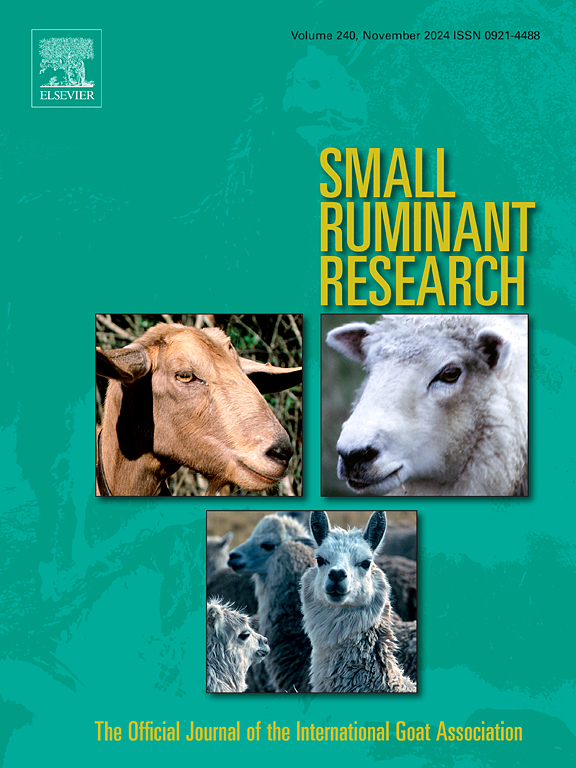Characterization and feeding value of mixed broccoli by-product silage for finishing lambs in confinement
IF 1.6
3区 农林科学
Q2 AGRICULTURE, DAIRY & ANIMAL SCIENCE
引用次数: 0
Abstract
The use of agricultural by-products in animal nutrition is increasingly being considered to address livestock feed shortages, reduce feed costs, and diminish environmental pollution. While some studies have investigated broccoli by-products as livestock feed, few have focused on the nutrition of finishing lambs. This study aims to evaluate the characteristics of broccoli by-product silage (BBS) and the effect of the complete replacement of forage with BBS in the diet of male Mehraban finishing lambs on growth performance, nutrient intake, digestibility, and meat characteristics. Sixteen Mehraban ram lambs (270.7 ± 1.4 days old; body weight of 28.3 ± 1.5 kg) were individually housed for 60 days and adapted to feed and housing for 14 days. The experimental diets included the control diet (diet without BBS) and the BBS diet (diet containing 330 g/kg DM BBS). The broccoli by-product before ensiling was mixed with wheat straw and ground barley grain in a ratio of 80:15:5 on a fresh weight basis. The pH, aerobic stability and Fleig point of BBS were 4.9, 71 h and 75.9, respectively. The values for dry matter intake and live weight at slaughter (LWS) were lower in lambs fed the BBS diet than in those fed the control diet (P < 0.001 and P = 0.03, respectively). Average daily gain and feed conversion ratio did not differ between lambs fed the experimental diets. The feed cost per kg and cost per kg of LWS in the BBS diet were 19.5 % and 25.7 % lower than in the control diet, respectively. Digestibility of nutrients (DM, OM, CP, EE, and NDF) did not differ between treatments. Most carcass traits and cuts did not differ between treatments (P > 0.05) but the longissimus lumborum m. (LL) muscle area (cm2), skin, brisket, and tail fat (as a percentage of LWS) were lower in lambs fed BBS than in those fed the control diet (P < 0.01). The internal organs (a percentage of LWS) of lambs fed the experimental diets were not affected by the treatments except for the heart (P = 0.005), which was higher in lambs fed the control diet. For meat color stability, no significant differences were observed in the values of lightness (L*), redness (a*), yellowness (b*), chroma, red color (R), green color (G), and blue color (B) between the two treatments, however, the hue angle (h*) was greater in lambs fed BBS than in those fed the control diet (P = 0.002). In conclusion, BBS can be fed to finishing lambs; however, further dose-response studies may be needed to determine the optimal levels and mixtures of BBS for inclusion in lamb diets.
混合花椰菜副产物青贮对坐月龄羔羊的特性及饲用价值
人们越来越多地考虑在动物营养中使用农业副产品,以解决牲畜饲料短缺、降低饲料成本和减少环境污染的问题。虽然一些研究调查了西兰花副产品作为牲畜饲料,但很少有研究关注育肥羔羊的营养。本试验旨在评价花椰菜副产物青贮(BBS)的特性,以及饲粮中完全替代花椰菜副产物青贮对雄Mehraban育肥羊生长性能、养分摄入量、消化率和肉品质的影响。16只美拉班公羊(270.7 ± 1.4日龄);体质量为28.3 ± 1.5 kg,单独饲养60 d,适应饲养和饲养14 d。试验饲粮分为对照饲粮(不含BBS)和BBS饲粮(含330 g/kg DM BBS)。青贮前的西兰花副产品与麦秸和大麦碎粒按新鲜重量80:15:5的比例混合。BBS的pH值为4.9,好氧稳定性为71 h, Fleig point为75.9。饲喂BBS饲粮的羔羊屠宰时干物质采食量和活重(LWS)值低于饲喂对照饲粮的羔羊(P分别为 <; 0.001和P = 0.03)。各组羔羊的平均日增重和饲料系数无显著差异。与对照饲粮相比,BBS饲粮的每kg饲料成本和每kg LWS成本分别降低19.5 %和25.7 %。营养物质(DM、OM、CP、EE和NDF)的消化率在不同处理之间没有差异。大多数胴体性状和切口在处理间无显著差异(P >; 0.05),但饲喂BBS的羔羊腰最长肌(LL)、肌肉面积(cm2)、皮肤、胸肉和尾脂肪(占LWS的百分比)低于对照组(P <; 0.01)。除心脏(P = 0.005)外,其余各脏器(LWS的百分比)均未受影响,对照组高于试验组(P < 0.05)。在肉色稳定性方面,两种处理的亮度(L*)、红度(a*)、黄度(b*)、色度、红色(R)、绿色(G)和蓝色(b)值均无显著差异,但色相角(h*)显著高于对照组(P = 0.002)。综上所述,育肥羔羊可饲喂BBS;然而,可能需要进一步的剂量反应研究来确定在羔羊日粮中添加BBS的最佳水平和混合物。
本文章由计算机程序翻译,如有差异,请以英文原文为准。
求助全文
约1分钟内获得全文
求助全文
来源期刊

Small Ruminant Research
农林科学-奶制品与动物科学
CiteScore
3.10
自引率
11.10%
发文量
210
审稿时长
12.5 weeks
期刊介绍:
Small Ruminant Research publishes original, basic and applied research articles, technical notes, and review articles on research relating to goats, sheep, deer, the New World camelids llama, alpaca, vicuna and guanaco, and the Old World camels.
Topics covered include nutrition, physiology, anatomy, genetics, microbiology, ethology, product technology, socio-economics, management, sustainability and environment, veterinary medicine and husbandry engineering.
 求助内容:
求助内容: 应助结果提醒方式:
应助结果提醒方式:


